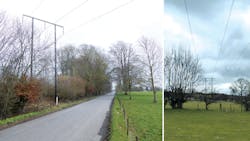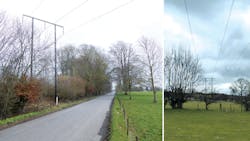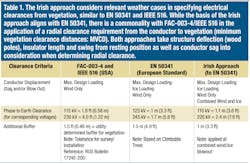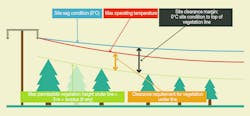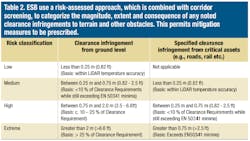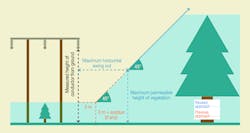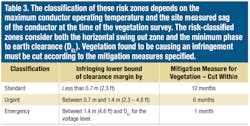ESB Manages Corridor Clearances With Risk-Assessment Approach
Statutory electrical clearance limits along overhead lines are a vital safety concern for electric utilities. Prudent and cost-effective management along network corridors is essential to eliminate clearance infringements from the ground, buildings, roads, vegetation and other infrastructure that can pose safety risks to the public and cause interruptions to electricity supply. Another reason to manage clearance limits is the reduced wind-cooling effects along overhead line corridors sheltered by vegetation, which can contribute to excess sags, resulting in a heightened risk of hazardous contact and a significant fire risk to the vegetation.
Considering the importance of adequately assessing these clearance requirements, ESB International developed an approach to prioritize the most urgent clearance infringements. The approach assesses the risks associated with the magnitude and extent of clearance infringements and categorizes them accordingly. During this process, ESB also identified challenges associated with the vegetation clearance requirements from overhead line conductors.
These requirements were reviewed, and priority-based clearance zones were defined based on conservative assessments of vegetation growth collected over consecutive years. This work has resulted in the development of a new risk-assessment method that combines technology and revised clearance requirements to prioritize as well as eliminate potential and actual clearance infringements along the route of an overhead line.
Big Data Challenges
ESB serves as the asset manager for Ireland’s transmission system and distribution network, which consists of more than 160,000 km (99,420 miles) of overhead lines. Controlling, processing and managing line data to help optimize future management decisions for these assets is a major challenge. ESB is making effective use of technologies, such as light detection and ranging (LiDAR), design software and purpose-built in-house applications, to help optimize asset management decisions. LiDAR surveys frequently are used to rapidly collect geospatial information and construct accurate 3-D models of existing overhead lines, which then can be used in conjunction with meteorological and line-load data collected at the time of the survey to perform thermal assessment calculations.
This data is particularly useful for providing accurate estimates of conductor temperature and sag, which helps to identify locations where any infringements of specified clearances are present. However, while the data collected in a LiDAR survey is beneficial, ESB encountered challenges with respect to the handling, organizing and storing of big data sets that contain point cloud data in addition to other line-load and meteorological information.
Thermal Rating Calculation
To solve the issue of data storage and help to optimize the analysis of LiDAR data, ESB developed an application called the Thermal Rating Data Manager (TRDM). The TRDM takes a formatted spreadsheet containing line-load and meteorological data in addition to importing line, span length and phase information from the design software as inputs. It then extracts the relevant span-specific information required to complete a thermal rating calculation through the design software’s thermal rating function.
Additionally, an innovative feature of this application is it applies corrections as necessary to the date, time, temperature, wind speed (including height adjustments), wind direction, solar radiation and line-load information efficiently and accurately. Using the TRDM application, the simultaneous processing of the line-specific information obtained from the LiDAR survey in conjunction with line-load and meteorological data enables the design software to determine the temperature of the overhead line during the survey. The calculation takes into consideration normal wind speeds and line-load conditions resulting in an estimation of the conductor temperature being accurate to within +/- 5°C (10°F).
The TRDM facilitates the rapid production of accurate clearance reports in accordance with ESB’s revised clearance limits for terrain, other obstacles and vegetation. With regards to terrain and obstacles, the process of identifying clearance infringements is enhanced considerably by the design software’s thermal rating calculator that determines the conductor temperature at the time of the LiDAR survey, following the raw data being processed and organized by the TRDM application. This capability enables ESB to assess the risk of any noted infringement on specified clearances.
Site Clearance Margin
In the past, ESB asset management inspectors encountered challenges with clearance rules for vegetation that required applying clearances specified for the conductor’s maximum operating temperature to overhead lines normally operating at lower load levels and temperatures. ESB has overcome these challenges using an innovative approach known as site clearance margin, which specifies the clearance requirements based on the assumption of conductor sag at a conservative 0°C (32°F) temperature for a range of typical spans. This approach assumes ambient temperatures of 15°C (59°F) and typical conductor temperatures of 5°C (41°F) above ambient. This ensures calculated conductor temperatures err on the conservative side even if the operating temperatures are higher than 0°C (32°F).
Specifying the site clearance margin has made it possible for ESB to relate vegetation heights to everyday site sag conditions at typical conductor operating temperature ranges and permitted the revised classification of both undergrowth grow-in and falling tree risks to overhead lines.
Falling Tree Risks
Consideration must be given to the falling distances of trees growing alongside the overhead line corridor to ensure appropriate clearances are provided. This is achieved by determining the limits of the horizontal swing-out zone, which refers to the distance an outer-phase conductor moves laterally from the vertical plane under high-wind or combined wind and ice conditions. By limiting the height of vegetation within the envelope formed by the horizontal swing-out zone to less than 3 m (10 ft) and specifying a maximum permissible height of vegetation at the horizontal swing-out zone boundary, the risk of vegetation falling and coming into contact with overhead line conductors is reduced significantly.
Furthermore, this new approach to falling tree risk also provides an allowance for positive transverse cross-slopes of up to 10% gradient. This mitigates a risk under the former approach whereby falling trees could come into contact with the overhead line in locations where the ground elevation of the tree base was higher than that under the overhead line.
Vegetation Risks
Vegetation undergrowth grow-in poses a more immediate risk to the security of overhead lines compared to falling tree risks. Undergrowth grow-in refers to the risk associated with vegetation beneath or adjacent to an overhead line growing vertically upward and infringing the minimum clearance requirements based on growth over a period of time, and it can occur in any weather conditions. To manage the risk posed by undergrowth grow-in, ESB developed a risk-assessment approach based on measured values for vegetation growth in Ireland. The approach classifies the danger grow-ins can pose to overhead lines based on the specification of risk levels for infringements on the clearance margin required at the conductor’s maximum design operating temperature. These clearance requirements can be related to normal line operating temperatures by the site clearance margin.
Three risk classifications were defined, which apply to the lateral distance from the outer-phase conductor determined by the horizontal swing-out zone, that consider both the clearance requirements for trees under overhead lines and the minimum phase-to-earth clearance. These classifications provide a consistent approach to the risk assessment of vegetation grow-in and enable prioritisation for mitigation measures based on projected growth rates.
The Approach In Action
As a result of concerns raised regarding the high loading and hot conductor joints on a 110-kV overhead line, ESB undertook a rapid thermal risk assessment of the circuit, constructed in the 1950s. Located in the midlands of Ireland, the overhead line is 41.7-km (25.9-miles) long and has large sections of the original 300-sq mm (0.465-sq inch) aluminum conductor steel-reinforced conductors still in place.
The TRDM application was used to facilitate the quick and accurate collection of line source data, obtained following a LiDAR survey of the line, for analysis by the thermal rating function in the design software. A total of 22 clearance infringements from terrain and other obstacles were identified. They ranged from low and medium risk clearance issues to more serious high and extreme risk clearance violations, identified under high-temperature weather conditions.
An assessment of the clearance requirements from the overhead line to the vegetation along the line corridor considering the revised clearance requirements also was performed with the design software, using a geospatial terrain model. ESB also conducted a vegetation clearance assessment to determine locations where vegetation posed grow-in and falling tree risks to the overhead line. A risk assessment of the vegetation undergrowth grow-in also was completed using the revised clearance criteria. A report was prepared and issued to the utility asset manager that outlined the clearance infringements identified and the recommended mitigation measures to overcome the clearance violations.
The use of technology played an important role in enabling efficient and effective asset management decisions to be made with regard to this particular 110-kV overhead line. Several clearance infringements were identified following the assessment process and targeted mitigation measures were recommended. This example highlights the innovative and productive approach ESB uses now to ensure continued public safety and network reliability.
Future Enhancements
The risk-assessment approach forms part of ESB’s revised vegetation management standard, introduced in fall 2019. The vegetation management standard was developed collaboratively among different stakeholders across the organization and tested in an ongoing basis. Positive feedback from the field during trial stages confirmed the advantages that fast and accurate measurement of potential clearance infringements can bring, enabling line inspectors to order targeted mitigation measures and specific preventive works.
ESB has identified several potential economic benefits from the introduction of this corridor clearance risk-assessment approach, such as a reduction in the number of LiDAR mobilizations to capture the network. By automating the rules for risk assessments and using a design software package to identify clearance infringements, ESB has reduced the need to model all its lines. Therefore, it can handle and process greater amounts of LiDAR data more efficiently and effectively. This will lead to economies of scale and help to reduce labor costs.
ESB may enhance its risk-assessment approach in the future. This includes developing a method for automatically identifying particular species of trees and vegetation as well as collecting information on the growth rates of these species. The utility also hopes to automate the clearance rules so potential and actual clearance infringements can be identified from the raw LiDAR data.
The introduction of an overhead line corridor clearance management risk-assessment approach has been a positive advancement for ESB. The revised clearance rules and vegetation management standard set out a clear path for efficiently and effectively managing corridor clearance infringements in addition to achieving economic benefits from the greater use of automation and technology.
Jason Noctor ([email protected]) is an overhead lines design engineer with engineering and major projects (EMP) at ESB International. Having completed a MSCE with business degree from the University College Dublin in 2017, Noctor began his career in the overhead line design standards group in EMP. He has worked closely with the asset management department at ESB to produce a vegetation management standard that can be applied practically in the field, and he has presented his work at both CIGRE and CEATI International Inc. conferences.
About the Author
Jason Noctor
Jason Noctor ([email protected]) is an overhead lines design engineer with engineering and major projects (EMP) at ESB International. Having completed a MSCE with business degree from the University College Dublin in 2017, Noctor began his career in the overhead line design standards group in EMP. He has worked closely with the asset management department at ESB to produce a vegetation management standard that can be applied practically in the field, and he has presented his work at both CIGRE and CEATI International Inc. conferences.
